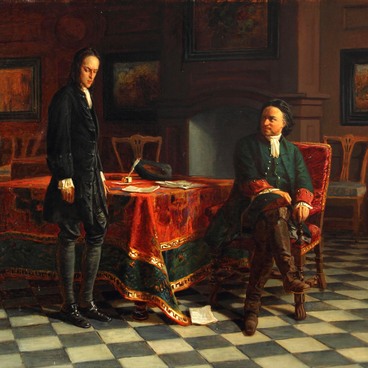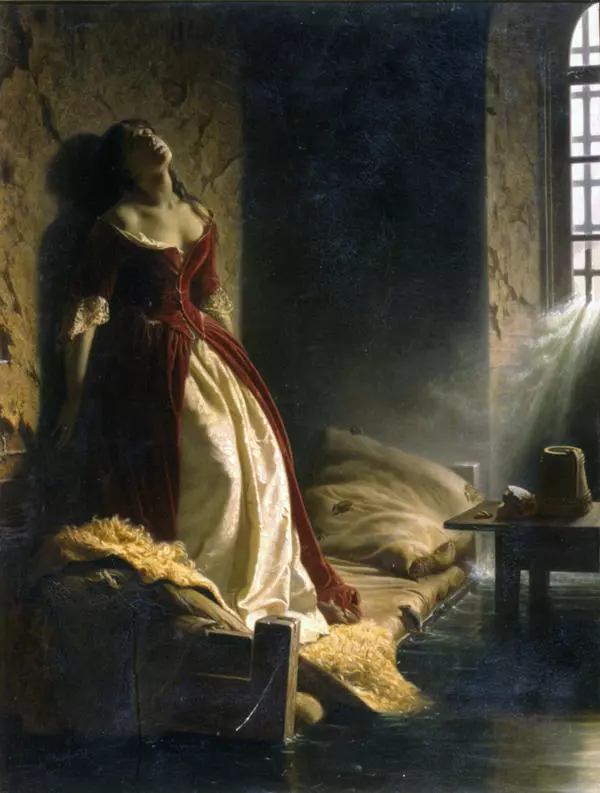The Imperial Academy of Arts traditionally upheld the idea that history painting was the only genre of painting that mattered. The Academy members at the time believed that history paintings boosted morale and educated the viewer. Hence, Academy students regularly studied the best samples of classical art taking in composition devices used by previous generations of painters and learning the ways of their artistic thinking. His academic training is vividly exemplified in this Dmitry Flavitsky’s study made in 1862 for his famous painting Christian Martyrs in the Colosseum.
Flavitsky studied art under the guidance of a Russian artist of Italian descent, Feodor Bruni who worked in the Academic style. Flavitsky graduated from the Academy with the big gold medal and a pension to pay for his tour of Europe. In 1855 he visited Italy where the events depicted in his painting had actually happened in times gone by. His canvas Christian Martyrs in the Colosseum painted in Rome earned him honorary membership of the Academy. Apparently, this study was also made while he was traveling in Italy.
Both the final painting and the study bespeak the influence of a muralist Karl Brullov whose work greatly impacted the style of Russian artists in the second third of the 19th century. The sinister red glow and the groups of people doomed and already resigned to fate in Flavitsky’s study are reminiscent of Brullov’s masterpiece The Last Day of Pompeii. Flavitsky’s goal here was to convey spiritual beauty of the sufferings endured by Christian martyrs, rather than stark realism of torture.
The artist might have been aware of the study weaknesses; the characters clearly fall into two distinct groups of fully positive and fully negative characters. They all express their feelings in exaggerated theatrical gestures creating an atmosphere of unwarranted pompousness and melodrama. In the final painting, the artist disposed of both the red glow and ostentatiously melodramatic postures of the people.
Still, the artist outlined prototypes of many characters for his future large canvas already in this study: the zealous preacher, the passive and submissive blind man, and the woman frozen in terror holding a child. The final version of Christian Martyrs in the Colosseum would have been impossible without this modest work showing the complicated process of translating the artist’s idea into his final work of art.
Flavitsky studied art under the guidance of a Russian artist of Italian descent, Feodor Bruni who worked in the Academic style. Flavitsky graduated from the Academy with the big gold medal and a pension to pay for his tour of Europe. In 1855 he visited Italy where the events depicted in his painting had actually happened in times gone by. His canvas Christian Martyrs in the Colosseum painted in Rome earned him honorary membership of the Academy. Apparently, this study was also made while he was traveling in Italy.
Both the final painting and the study bespeak the influence of a muralist Karl Brullov whose work greatly impacted the style of Russian artists in the second third of the 19th century. The sinister red glow and the groups of people doomed and already resigned to fate in Flavitsky’s study are reminiscent of Brullov’s masterpiece The Last Day of Pompeii. Flavitsky’s goal here was to convey spiritual beauty of the sufferings endured by Christian martyrs, rather than stark realism of torture.
The artist might have been aware of the study weaknesses; the characters clearly fall into two distinct groups of fully positive and fully negative characters. They all express their feelings in exaggerated theatrical gestures creating an atmosphere of unwarranted pompousness and melodrama. In the final painting, the artist disposed of both the red glow and ostentatiously melodramatic postures of the people.
Still, the artist outlined prototypes of many characters for his future large canvas already in this study: the zealous preacher, the passive and submissive blind man, and the woman frozen in terror holding a child. The final version of Christian Martyrs in the Colosseum would have been impossible without this modest work showing the complicated process of translating the artist’s idea into his final work of art.




